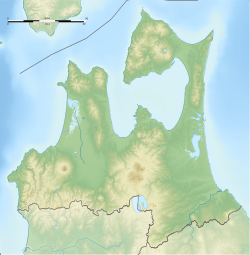Kanehiranari-en
| Kanehiranari-en | |
|---|---|
| 金平成園 | |
 Kanehiranari-en | |
| Type | Urban park |
| Location | Kuroishi, Aomori, Japan |
| Coordinates | 40°38′36.3″N 140°35′33″E / 40.643417°N 140.59250°E |
| Area | 5,662 square metres (1.399 acres) |
| Created | 1882-1902 |
| Operated by | Kuroishi city |
| Status | Open May through November |
Kanehiranari-en (金平成園), also known as Sawanari-en (澤成園) is a Japanese landscape garden and nationally designated Place of Scenic Beauty in the city of Kuroishi, Aomori Prefecture, Japan.[1][2][3][4]
Overview
[edit]This garden was laid out in the late Meiji period Katō Uehei, a wealthy local businessman and politician, and was initially intended as a work of charity to provide employment to impoverished local farmers. It was designed by Takahashi Teizan, the leading gardener of the Oishi Bugaku Ryu style of Japanese gardens in 1882 and was completed by two of his pupils in 1902. The garden consists of a large pond on the left hand side of the main building with a complex stone-structured shoreline. Stepping stones extend from the main building in two directions, and the garden is studded with large megaliths, including a large conical mound intended to emulate Mount Iwaki and several stone Tōrō (Japanese lanterns).[citation needed]
On the west side of the garden is the former Katō family residence, which consists of a main house and a detached tea room, which were constructed in 1902. The garden remained in private hands until it was donated to Kuroishi city in November 2019.[5]
The gardens are about an eight minute walk from Kuroishi Station on the Kōnan Line.[citation needed]
See also
[edit]References
[edit]- ^ "Kanehiranarien (Sawanarien)". Agency for Cultural Affairs. Retrieved 10 February 2012.
- ^ "金平成園 (澤成園)". Agency for Cultural Affairs. Retrieved 10 February 2012.
- ^ "Cultural Properties of Kuroishi". Kuroishi City. Retrieved 10 February 2012.
- ^ "Kanehiranarien (Sawanarien)". Aomori Prefecture. Retrieved 10 February 2012.
- ^ "金平成園(黒石)所有者が市に無償譲渡". Mutsu Shinpo (in Japanese). 9 January 2020. Retrieved 13 May 2023.
External links
[edit]- Aomori Prefectural Government (in Japanese)
- Kuroishi City site (in Japanese)
- Kuroishi Tourist Association (in Japanese)
Text is available under the CC BY-SA 4.0 license; additional terms may apply.
Images, videos and audio are available under their respective licenses.


